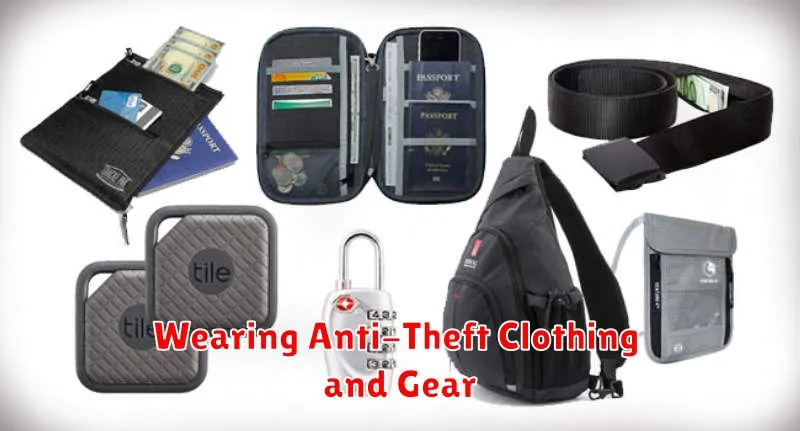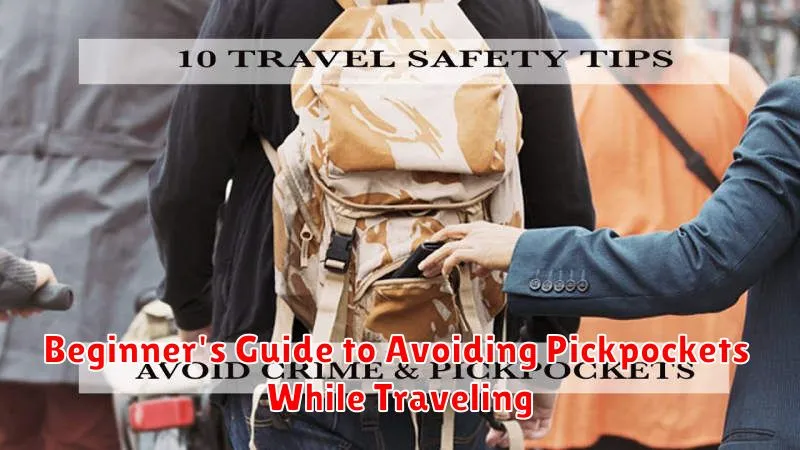Traveling can be an enriching experience, but it’s crucial to be aware of potential risks, especially pickpocketing. Pickpockets target unsuspecting travelers, often in crowded tourist areas. This beginner’s guide provides essential tips and strategies to help you avoid pickpockets and keep your belongings safe while traveling. Learning how to protect yourself from pickpockets is a vital part of travel preparation, ensuring a worry-free and enjoyable trip.
From understanding common pickpocketing techniques to implementing practical anti-theft measures, this guide will equip you with the knowledge you need to stay one step ahead of potential thieves. We’ll cover everything from choosing the right travel gear to adopting safe habits that will minimize your risk. Whether you’re a first-time traveler or a seasoned globetrotter, understanding how to avoid being pickpocketed is essential for a smooth and secure travel experience. Let’s explore the key steps to safeguard your valuables and enjoy your travels with peace of mind.
How Pickpockets Target Tourists
Pickpockets often target tourists due to their unfamiliarity with the area and potential distractions. Tourists are often preoccupied with navigating, taking photos, or consulting maps, making them less aware of their surroundings and belongings. Crowded areas like popular attractions, public transportation, and markets are prime hunting grounds for pickpockets, providing cover and opportunities for theft. Additionally, tourists may carry larger amounts of cash and valuable electronics, making them attractive targets.
Pickpockets employ various tactics to steal from unsuspecting individuals. Distraction techniques are common, such as bumping into someone, asking for directions, or creating a staged commotion. These distractions divert the victim’s attention, allowing the pickpocket to swiftly lift wallets, phones, or other valuables. They may also work in teams, with one person creating a distraction while another performs the theft. Sharp objects like razors or small knives can be used to discreetly cut bags or pockets.
To protect yourself from pickpockets, it’s essential to be vigilant and aware of your surroundings, especially in crowded areas. Keep your valuables securely stored in a closed bag or inner pocket, and avoid carrying excessive amounts of cash. Be wary of unexpected interactions or distractions, and maintain a firm grip on your belongings. Consider using anti-theft bags or accessories for added security. If you suspect someone is attempting to pickpocket you, immediately move away and check your belongings.
Where Pickpockets Are Most Active
Pickpockets thrive in crowded and distracting environments. These locations offer them cover and opportunity, allowing them to operate unnoticed. Tourist attractions, public transportation hubs (especially during rush hour), and large events like festivals or concerts are prime locations for pickpocketing activity. Be extra vigilant in these settings.
Markets, shopping malls, and restaurants also present opportunities for pickpockets. In these locations, people are often preoccupied with shopping, eating, or socializing, making them less aware of their surroundings. Pickpockets can easily bump into you in a crowded market or lift your wallet from your bag hanging on the back of a chair in a restaurant.
While less common, pickpocketing can also occur in seemingly safer locations like museums, theaters, and even places of worship. The key takeaway is to be aware of your surroundings and take precautions to protect your belongings regardless of where you are.
Wearing Anti-Theft Clothing and Gear

Anti-theft clothing and gear offer a discreet way to protect your valuables while traveling or in crowded areas. These items often incorporate hidden pockets, slash-resistant materials, and locking mechanisms to deter pickpockets and thieves. Consider wearing clothing with zippered or buttoned pockets close to your body, and utilize hidden pouches worn under your clothes for important documents, cash, and cards. Secure straps on bags and backpacks can also help prevent snatch-and-grab thefts.
When choosing anti-theft clothing and gear, prioritize functionality and comfort. Look for items made from lightweight, breathable materials, especially if you plan to wear them in warm climates. Ensure that the hidden pockets and compartments are easily accessible to you, but difficult for others to reach. Consider the overall style and design of the clothing or gear to ensure it aligns with your needs and travel plans. A simple, inconspicuous design is often the most effective.
While anti-theft clothing and gear can be valuable tools in protecting your belongings, it’s essential to remember that they are not foolproof. Always maintain situational awareness and take additional precautions to protect yourself from theft. Avoid displaying expensive jewelry or electronics, and be mindful of your surroundings, especially in crowded or unfamiliar areas. Combining anti-theft gear with vigilant travel practices offers the best defense against theft.
Keeping Valuables in Safe Spots
Protecting your valuables requires careful consideration of storage locations. Avoid obvious places like dresser drawers or under mattresses. Instead, opt for less predictable spots like inside hollowed-out books, behind removable wall panels, or within a designated safe. Prioritize locations that are both hidden and difficult to access quickly, deterring opportunistic thieves. Consider the size and nature of the item; smaller, high-value items like jewelry might require different hiding spots compared to larger items such as important documents.
A home safe can provide an additional layer of security. When choosing a safe, consider factors like fireproofing, water resistance, and mounting options. A bolted-down safe makes it significantly harder to steal. Ensure the safe’s combination or key is stored securely in a separate location, known only to trusted individuals. Digital safes offer convenient access but require reliable power sources and strong passwords.
For extremely valuable items or irreplaceable documents, consider using a safety deposit box at a bank. These boxes are housed in secure vaults, offering protection against theft, fire, and natural disasters. While there are fees associated with renting a safety deposit box, the peace of mind they provide can be invaluable for protecting essential documents and prized possessions.
How to React If You’re Targeted
Being targeted can be a frightening experience. If you feel you are being targeted, it is crucial to prioritize your safety. Increase your situational awareness by paying close attention to your surroundings and any unusual activity. Document everything, including dates, times, specific actions, and descriptions of individuals involved. If possible, secure any evidence, such as photos or videos, while prioritizing your personal safety. Immediately report the incident to the appropriate authorities, providing them with all the documented information. Depending on the nature of the targeting, you may also want to inform trusted friends, family, or colleagues.
Depending on the severity and nature of the targeting, consider taking further steps to protect yourself. This might include changing your routines, varying your travel routes, enhancing security measures at your home or workplace, or seeking a restraining order if legally applicable. If the targeting involves online harassment or threats, report the activity to the relevant platforms and adjust your privacy settings. Consider seeking professional guidance from a security expert or legal counsel to assess your specific situation and develop a tailored safety plan.
Remember to prioritize your well-being throughout this experience. The emotional impact of being targeted can be significant. Reach out to your support system, including friends, family, and mental health professionals. They can provide valuable emotional support and help you cope with the stress and anxiety that can arise from such a situation. Taking care of your emotional and mental health is essential for navigating this challenging time.
Pickpocket Tricks You Should Know

Pickpockets are skilled at distraction and misdirection. They often work in teams or groups, creating a chaotic situation to bump into you seemingly by accident. This bump is often when the theft occurs. Other common tactics include “helping” you with your luggage or asking for directions while an accomplice lifts your valuables. Be aware of your surroundings, especially in crowded areas, and keep your valuables close.
Secure your belongings. Keep wallets in your front pocket, and purses zipped and close to your body. Consider using a money belt or hidden pouch for extra security, especially when traveling. Avoid leaving valuables unattended in public places, even for a short time. A seemingly empty bag left on a chair can be a tempting target.
Be wary of overly friendly strangers. While most people are genuinely kind, be cautious of those who seem overly eager to assist you, especially if it involves physical contact. Trust your instincts. If a situation feels uncomfortable or suspicious, remove yourself from it immediately.
Staying Alert Without Feeling Paranoid
Staying alert refers to maintaining a state of awareness of your surroundings without succumbing to excessive fear or suspicion. It’s about being present and observant, noticing details and potential risks, while still feeling safe and in control. This involves paying attention to your gut feelings and trusting your intuition, but not letting anxiety dictate your actions. Instead of constantly scanning for threats, cultivate a calm awareness that allows you to react appropriately if a situation arises.
Practical tips for staying alert include maintaining situational awareness by observing people and activities around you, especially in unfamiliar environments. Avoid distractions like constantly being on your phone, and trust your instincts if something feels off. Preparation can also contribute to feeling alert but not paranoid. Planning your route, sharing your itinerary with someone you trust, and being familiar with emergency procedures can enhance your sense of security.
The difference between alertness and paranoia lies in your interpretation of information. Alertness involves objectively assessing potential risks, while paranoia involves interpreting ambiguous situations as threatening, often without evidence. If you find yourself constantly worrying about unlikely scenarios or experiencing persistent fear and anxiety, it’s important to seek professional help. A mental health professional can help you distinguish between realistic concerns and unfounded fears, and develop coping mechanisms to manage anxiety.

